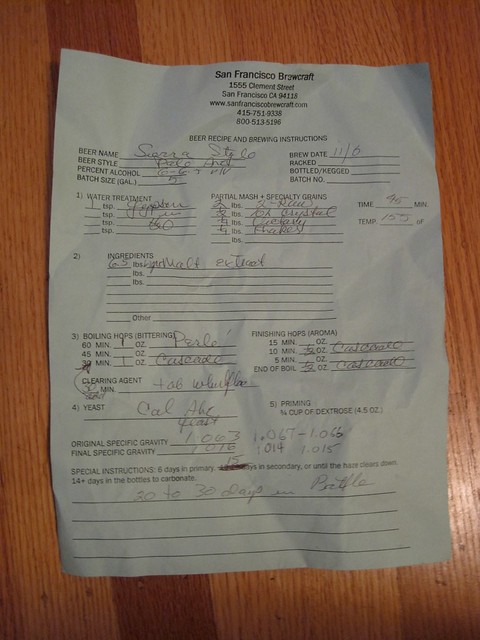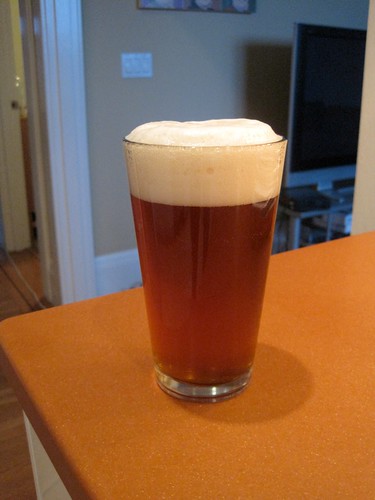
If you are getting tired of using beer kits or following other peoples recipes and are ready to start creating your own beers, this post is for you. When I first moved out to San Francisco I started putting
Sierra Nevada Pale Ale in my keggerator on a regular basis. I was impressed by how fresh the kegs were and most of my friends liked it as well. After going through a few of them I decided it would be a good idea to try brewing it on my own.
I started off with a clone recipe I found online and then tried another recommended by
Griz at SF Brewcraft a few months after that. Both turned out really good. Over the years I have been modifying it slightly each time I make it. It's been through about seven iterations at this point.
I started off by adjusting the hops and hop schedule (the timing of when you add your hops; you can see the hop schedule in my original recipe sheet, above). Then, I moved on to playing around with the specialty grains. Each time, I tweak it a little differently depending upon my mood.
Here are my easy pointers to writing your OWN beer recipes:
1.) Pick a style of beer you like (for me it was the west coast style pale ale). Then brew a few different recipes you find online or you get from your local brew mentor. If you do not have a Brew Mentor, definitely get one. It's easy since pretty much everyone that brews also loves talking about it. One of my Brew Mentors is Griz from SF Brewcraft.
2.) Improvise: make some minor adjustments on your own starting with types of hops or hop schedule and specialty grains. Try to stick to the same brewing techniques and processes to keep that variable constant.
3.) Ask an expert: review your changes with someone who knows what they are doing (again, your Brew Mentor--I do this ALWAYS with all my recipes, not because I am paranoid, but because he teaches me a LOT). For example, you will get comments like, "keep the flaked barley for head retention" or, "that hop is going to add spiciness" etc. If you have some flavor profiles in mind just ask. Like, "How can I get a more roasty flavor?" or "What can I do to get more floral aroma".
4.) Taste, adjust, and repeat: every time you do this it will open your eyes to new things. Once you have adjusted some of the specialty grains and hops enough, you have pretty much written your own recipe.
Here is my latest IPA, which I've brewed about seven times, adjusting the recipe along the way.

You could keep going on like this, move onto different styles, and gain an understanding of each one. At some point you will probably be interested enough to learn a little more about the science of brewing beer. I highly recommend reading
Designing Great Beers, which will open your eyes to the intricacies of the process and teach you a lot about different beer styles along the way.
Next, I'll follow-up with a post on the dos and don'ts of experimenting with specialty grains for your own recipes and the hop schedules.
Good luck!
-CJ
 If you are getting tired of using beer kits or following other peoples recipes and are ready to start creating your own beers, this post is for you. When I first moved out to San Francisco I started putting Sierra Nevada Pale Ale in my keggerator on a regular basis. I was impressed by how fresh the kegs were and most of my friends liked it as well. After going through a few of them I decided it would be a good idea to try brewing it on my own.
I started off with a clone recipe I found online and then tried another recommended by Griz at SF Brewcraft a few months after that. Both turned out really good. Over the years I have been modifying it slightly each time I make it. It's been through about seven iterations at this point.
I started off by adjusting the hops and hop schedule (the timing of when you add your hops; you can see the hop schedule in my original recipe sheet, above). Then, I moved on to playing around with the specialty grains. Each time, I tweak it a little differently depending upon my mood.
Here are my easy pointers to writing your OWN beer recipes:
1.) Pick a style of beer you like (for me it was the west coast style pale ale). Then brew a few different recipes you find online or you get from your local brew mentor. If you do not have a Brew Mentor, definitely get one. It's easy since pretty much everyone that brews also loves talking about it. One of my Brew Mentors is Griz from SF Brewcraft.
2.) Improvise: make some minor adjustments on your own starting with types of hops or hop schedule and specialty grains. Try to stick to the same brewing techniques and processes to keep that variable constant.
3.) Ask an expert: review your changes with someone who knows what they are doing (again, your Brew Mentor--I do this ALWAYS with all my recipes, not because I am paranoid, but because he teaches me a LOT). For example, you will get comments like, "keep the flaked barley for head retention" or, "that hop is going to add spiciness" etc. If you have some flavor profiles in mind just ask. Like, "How can I get a more roasty flavor?" or "What can I do to get more floral aroma".
4.) Taste, adjust, and repeat: every time you do this it will open your eyes to new things. Once you have adjusted some of the specialty grains and hops enough, you have pretty much written your own recipe.
Here is my latest IPA, which I've brewed about seven times, adjusting the recipe along the way.
If you are getting tired of using beer kits or following other peoples recipes and are ready to start creating your own beers, this post is for you. When I first moved out to San Francisco I started putting Sierra Nevada Pale Ale in my keggerator on a regular basis. I was impressed by how fresh the kegs were and most of my friends liked it as well. After going through a few of them I decided it would be a good idea to try brewing it on my own.
I started off with a clone recipe I found online and then tried another recommended by Griz at SF Brewcraft a few months after that. Both turned out really good. Over the years I have been modifying it slightly each time I make it. It's been through about seven iterations at this point.
I started off by adjusting the hops and hop schedule (the timing of when you add your hops; you can see the hop schedule in my original recipe sheet, above). Then, I moved on to playing around with the specialty grains. Each time, I tweak it a little differently depending upon my mood.
Here are my easy pointers to writing your OWN beer recipes:
1.) Pick a style of beer you like (for me it was the west coast style pale ale). Then brew a few different recipes you find online or you get from your local brew mentor. If you do not have a Brew Mentor, definitely get one. It's easy since pretty much everyone that brews also loves talking about it. One of my Brew Mentors is Griz from SF Brewcraft.
2.) Improvise: make some minor adjustments on your own starting with types of hops or hop schedule and specialty grains. Try to stick to the same brewing techniques and processes to keep that variable constant.
3.) Ask an expert: review your changes with someone who knows what they are doing (again, your Brew Mentor--I do this ALWAYS with all my recipes, not because I am paranoid, but because he teaches me a LOT). For example, you will get comments like, "keep the flaked barley for head retention" or, "that hop is going to add spiciness" etc. If you have some flavor profiles in mind just ask. Like, "How can I get a more roasty flavor?" or "What can I do to get more floral aroma".
4.) Taste, adjust, and repeat: every time you do this it will open your eyes to new things. Once you have adjusted some of the specialty grains and hops enough, you have pretty much written your own recipe.
Here is my latest IPA, which I've brewed about seven times, adjusting the recipe along the way.
 You could keep going on like this, move onto different styles, and gain an understanding of each one. At some point you will probably be interested enough to learn a little more about the science of brewing beer. I highly recommend reading Designing Great Beers, which will open your eyes to the intricacies of the process and teach you a lot about different beer styles along the way.
Next, I'll follow-up with a post on the dos and don'ts of experimenting with specialty grains for your own recipes and the hop schedules.
Good luck!
-CJ
You could keep going on like this, move onto different styles, and gain an understanding of each one. At some point you will probably be interested enough to learn a little more about the science of brewing beer. I highly recommend reading Designing Great Beers, which will open your eyes to the intricacies of the process and teach you a lot about different beer styles along the way.
Next, I'll follow-up with a post on the dos and don'ts of experimenting with specialty grains for your own recipes and the hop schedules.
Good luck!
-CJ




Comments (0)
There are no comments for this article. Be the first one to leave a message!